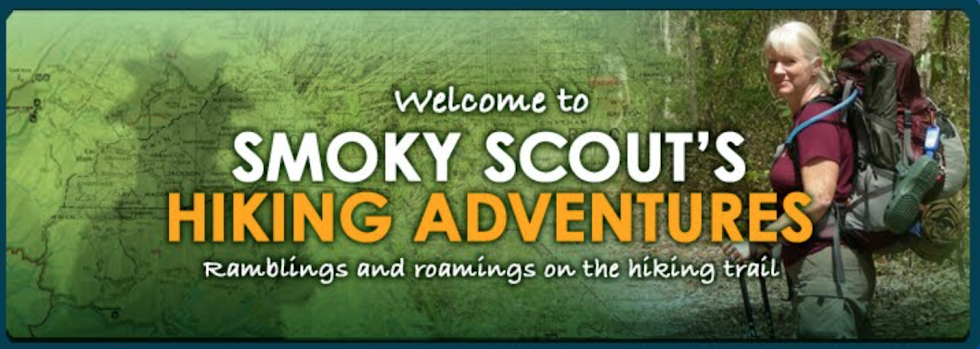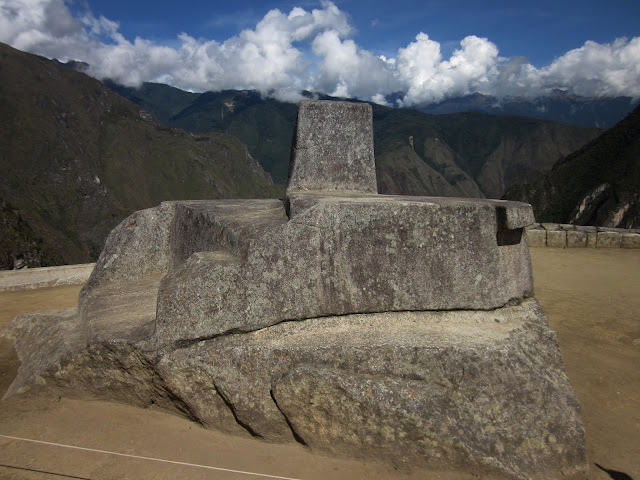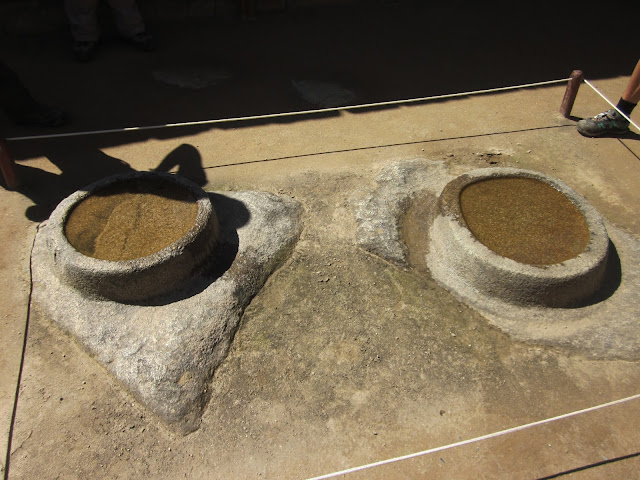Adventures in Peru – 6/13/14 – Machu Picchu – 6 Km
Why even go to sleep if we have to be up at 3:30 a.m.? Because now our natural state is perpetual
exhaustion that overwhelms a side order of summit jitters. The coming day is going to be long and
action-packed (some things expected, some surprises) and sleep we do.
Coca tea arrives at our tent door as usual, this time with a
paper bag breakfast. The urgency is
palpable throughout the camp, hikers talking in rushed voices, headlamps
flashing every which way, hurrying for one last trip to the now-disgusting
bathrooms. Do we have everything? Say goodbye to our fabulous team of porters
and our lovely cook. Count heads, are we
all ready? Vamos!
We walk for approximately seven minutes (yes, minutes) to a
big concrete platform covered by a thatched roof. A long wooden bench stretches down the length
of one side, perhaps 60 feet. This is
the final checkpoint on the Inca Trail before reaching Machu Picchu. We are the third group in line and barely
squeeze in under the roof, which is excellent because we hear a light
pitter-patter in the trees that close in around the platform.
The check point officer is scheduled to arrive at 5:30 a.m.,
which means an hour and a half of sitting in the dark with 150 other anxious
trekkers. (Yes, he has to hike in from
somewhere.) Get settled, pretend like
you’re waiting for Grateful Dead tickets in the ‘70’s. Backpacks propped up as pillows for yawning
people, cell phones creating small pools of light to play games, decks of cards
coming out for shuffling and dealing, rustling around in our paper bags to see
what’s for breakfast.
A surreal moment that I will remember forever: Cathy and I brushing our teeth and spitting
toothpaste off the platform edge into the darkness of the rain forest as
someone’s tiny portable radio plays Adele singing “Rolling In The Deep.” Just put yourself there with us. Crazy, huh?
After an hour Cathy and I decide to walk seven minutes back
up the hill to the bathrooms again (still pitch dark). As we approach, one door opens and a young
Asian woman stumbles out, gagging, “I’ve got to get out!” Cathy doesn’t even glance at her, just
catches the door behind her and walks on into the stall. When she exits, she comments on how filthy it
was, and I blandly say that the poor woman retching was a clue that you might
not want to go in there. Cathy just
shrugs.
Movement ahead of us, everyone getting to their feet, hoisting backpacks and shuffling forward, and we get our passports stamped a final time. Ahead of us are six kilometers of relatively easy trail, hugging the rock faces of the mountain called Machu Picchu. We have the added stress of other hikers on our heels, so there are few moments for stopping to take photographs, but I try to appreciate these last footsteps on this adventure. The only photo I took: one steep set of stairs.
Movement ahead of us, everyone getting to their feet, hoisting backpacks and shuffling forward, and we get our passports stamped a final time. Ahead of us are six kilometers of relatively easy trail, hugging the rock faces of the mountain called Machu Picchu. We have the added stress of other hikers on our heels, so there are few moments for stopping to take photographs, but I try to appreciate these last footsteps on this adventure. The only photo I took: one steep set of stairs.
Intipunku, the Sun Gate
Chris at the Sun Gate
The big finale on many bucket lists is watching the sun rise
over Machu Picchu from the Sun Gate, but the moment is often anti-climatic, hazy
or foggy. Daylight arrived before we did
and light clouds at first obscure the view, but as we watch a breeze moves the
clouds first right, then left, covering and uncovering the ancient ruins.
Sitting on the wall of the Sun Gate
The crowd scene, unlike what I anticipated, is quietly
celebratory. That first look down at
Machu Picchu is truly breathtaking. The
improbability of these structures hanging on a narrow saddle between these
impossibly high and jagged mountains is staggering. As each new group tops the last set of stairs
we watch as mouths drop and eyes pop, and we all smile and whisper, “Like, I
know, right?” The past four days of labored breathing, aching muscles, and inadequate rest melt away.
Washington encourages us not to linger at the Sun Gate,
saying he knows several better vantage points for photos on the hour-long hike
down to the site. We layer up for the
descent in the morning chill and…Vamos!
Clouds gradually uncovering Machu Picchu
With every step the clouds dissipate and we are gifted with
a spectacularly clear day on the mountain.
The triumphant Spanglish Team at Machu Picchu.
Huyana Picchu ("Young Mountain") is the dramatic craggy mountain backdrop to the site. For an extra fee you can climb it.
When the trail reaches the top level of the ruins, Washington
leads us out of the entrance gate (what?) and down steps to a café where we
take a little time to eat, use the real! flushing! toilets and wash up in a
reasonable fashion. I change into my beloved
Virginia Tech tee shirt and Andy sports his South Carolina Gamecocks pride. Only small daypacks are allowed inside Machu
Picchu (I’ve brought a drawstring bag with me) so we must take time to downsize
and then check our backpacks for safekeeping during our tour.
Washington disappears for a bit and when he returns he too
is cleaned up – very nicely! We cheer as
he enters the café area with a clean collared white shirt, a vest and slickly
combed hair. We are ready for our guided
tour of Machu Picchu.
Okay, if you are looking for a detailed description of Machu Picchu’s history and archeology, you won’t find it here. I have some notes to go with my photos but few specifics. The most basic theories: Built between 1450 and 1470 to accommodate about 1,000 people, Machu Picchu was probably a self-sustaining royal retreat that included housing for servants and structures for religious purposes. The invading Spanish never discovered this remote enclave, but the reason why Machu Picchu was abandoned is not definitively known. It was rediscovered in 1911 by Hiram Bingham, an American explorer. (I recommend The Inca Trail: Cusco & Machu Picchu by Alexander Stewart as a guidebook if you are thinking of experiencing Machu Picchu and/or an Inca Trail trek.)
I enjoy three hours of wandering with Washington and my
friends, constantly looking down over walls, behind boulders, up steep
staircases and down cascading terraces, imaging a people living, sleeping,
eating and worshiping in this suspended dream.
Take a look.
Designated area for tour groups to “pull over” out of
the walking path
Andy is sneaking up on a spider’s web in the bromeliad
foliage
The building in the top center has a new thatched roof to
replicate the original living quarters.
All pyramid-shaped walls are the ends of buildings missing their
thatched roofs.
Tomb of the Princess
A tree grows in Machu Picchu
Terraces and buildings for storage
Quarry where stones were harvested and then moved and shaped
for construction
Oops
Intihuatana, “the Hitching Post of the Sun,” a stone carved
in situ (part of the mountain, not placed there)
Looking down from Intihuatana with Huyana Picchu looming large
Standing on the Central Plaza looking at Machu Picchu Mountain
Inside a reconstructed thatched roof
Inside a small walled, roofless room two carved stone pools filled with water
reflect the night sky to observe the
stars
Temple of the Condor (do these two leaning boulders look
like wings?)
Carved stone at the base of the winglike boulders completes
the condor
Our tour is finished and our group splits up for more
exploration, with a plan to meet for a late lunch in the town of Aguas Calientes
(a short bus ride…yes, you can just take a bus). Andy, Chris and Cathy go off on a short hike
to a viewpoint, but I’ve had enough, so I walk with Washington back to the café
area, where I order a very tall Orange Crush and take a seat. An hour later, my friends return and we hop
on the bus for the precarious, winding ride down the mountain.
The town of Aguas Calientes is compact and very enticing, but we don’t have much time for looking around because we have people to meet and lunch to eat. At the restaurant Apu Salkantany we reunite with Washington and the Spanglish team. After ordering my food, I borrow Cathy’s cell phone to call home. Much of my discomfort on the trek has been preoccupation with things at home, and when I finally get a call through I learn that Jim has changed my flights to return home sooner than originally planned – in fact, the next day. Anxiety reignites, and along with it comes worry at disappointing my friends, but I also feel relief that a plan has been determined. I am still on the phone and a little emotional when Washington hugs me goodbye.
I break the news to my friends that I will not be continuing on with them for a second week of Peruvian excitement to Lake Titicaca, Colca Canyon and Arequipa. It changes the dynamic a little bit but I don’t think they are surprised. Then we concentrate on lunch: for me, a chicken sandwich with pickles, lettuce, avocado and a fried egg, topped with potatoes. Perfect.
Pre-dawn hiking, a tour of one of the seven wonders of the
world, a charming little Peruvian town, and there are still hours left to
fill. Did someone say hot springs?
Aguas Calientes = hot water. Remember that bathing suit I carried for the entire trek? If you’re going, be sure not to miss this. You can rent a towel on the street as you walk up (again? Up.) to the entrance to Hot Springs.
Aguas Calientes = hot water. Remember that bathing suit I carried for the entire trek? If you’re going, be sure not to miss this. You can rent a towel on the street as you walk up (again? Up.) to the entrance to Hot Springs.
After a great soak, we board our train for the two-hour ride
back to Ollantaytambo, where a shuttle bus will take us on to Cusco, back to
Casa Elena, where we have left our luggage and plan to spend one more brief
night. When we get off the train, the
streets are teeming with people, drivers holding up cardboard signs with
handwritten names, everyone shouting.
It’s dark and we are straining to read lists of names as people push and
shove to connect with their drivers. We
see a sign with the names of Maria, Sergi, Cami and Francine – but not
ours. A wave of anxiety washes over me
as I realize that we do not have a connection here.
Maria sees the confusion and begins to berate her
driver. Why does he not have our
names? We are supposed to be traveling
with them all the way to Cusco. He
shrugs, continues to collect the other people on his list, and they walk
towards the shuttles. The lack of
sufficient Spanish to communicate is crucial now and I don’t know what to do
next. But then Francine sees the look of
incredulity on my face. She smiles at
me, puts her hand on my arm and crooks her finger in a “come with me”
gesture. She says, “Solucion
solamente.” We follow our Spanglish team
friends to the shuttle buses as Maria continues to speak vehemently to the
driver – she will not let him leave us.
Finally he acquiesces, indicates that we should squeeze onto one of the
buses. We realize that our friends are
going on the other bus, so we hug goodbye too quickly and the connection is
lost forever – no email addresses, no Facebook pages, no phone numbers.
All the way to Cusco I ride in the front seat with the
driver, ready to yell “Stop!” as soon as I see something familiar. We disembark at the Plaza de Armas (11:00
p.m. and the place is partying) and we walk the familiar few blocks to Casa
Elena.



































No comments:
Post a Comment